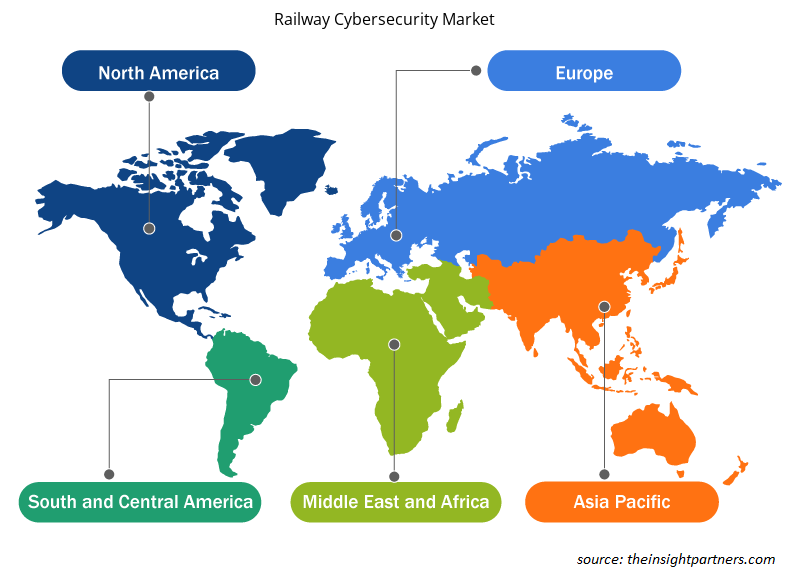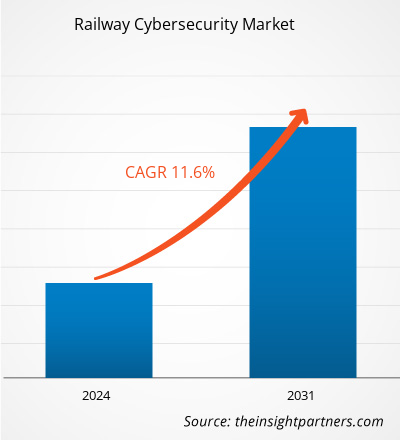철도 사이버 보안 시장 규모는 2023년 75억 1,000만 달러에서 2031년 1,802억 달러로 성장할 것으로 예상됩니다. 이 시장은 2023~2031년 동안 11.6%의 CAGR을 기록할 것으로 예상됩니다. 사이버 공격의 증가와 철도에서 스마트 모빌리티 솔루션의 채택 증가는 시장의 주요 동인이자 추세가 될 가능성이 높습니다.
철도 사이버 보안 시장 분석
철도 사이버 보안 시장은 전 세계적으로 상당한 성장을 경험하고 있습니다. 이러한 성장은 사이버 공격의 증가와 철도에서 스마트 모빌리티 솔루션의 채택 증가에 기인합니다. 게다가 사이버 보안 법률 및 규정의 증가와 클라우드 기반 사이버 보안 서비스에 대한 수요 증가는 향후 몇 년 동안 철도 사이버 보안 시장 성장을 견인할 것으로 예상되는 요인입니다.
철도 사이버 보안 시장 개요
철도의 사이버 보안은 디지털 시스템과 기술에 대한 의존도가 높아짐에 따라 매우 중요해지고 있습니다. 철도가 더욱 현대화됨에 따라 신호 및 트랙 관리부터 승객 관리 및 티켓팅에 이르기까지 운영을 모니터링하고 제어하기 위해 다양한 컴퓨터 기반 시스템을 채택했습니다. 이러한 디지털화로 인해 철도 시스템은 승객 과 운영자에게 더욱 편리하고 효율적이 되었습니다.
귀하의 요구 사항에 맞게 이 보고서를 사용자 정의하세요
이 보고서의 일부 또는 국가 수준 분석, Excel 데이터 팩을 포함하여 모든 보고서에 대한 사용자 정의를 무료로 받을 수 있으며 신생 기업 및 대학을 위한 훌륭한 혜택과 할인 혜택을 이용할 수 있습니다.
-
이 보고서의 주요 시장 동향을 알아보세요.이 무료 샘플에는 시장 동향부터 추정 및 예측까지 다양한 데이터 분석이 포함됩니다.
철도 사이버 보안 시장 동인 및 기회
사이버 공격 증가로 시장 호조
철도의 중요 인프라는 점점 더 잠재적인 사이버 공격에 노출되고 있습니다. 모든 부문에서 연결성과 기술 활용은 시민에게 제공되는 서비스를 개선하고, 프로세스와 리소스를 최적화하며, 각 운영자의 행동의 질을 향상시켰습니다. 하지만 이러한 연결성은 또한 어두운 측면을 가지고 있으며, 해당 서비스를 공격하고 방해할 수 있는 악의적인 행위자의 행동을 용이하게 합니다. 이 부문은 운영에 상당한 영향을 미칠 수 있는 여러 사이버 위협에 직면해 있습니다. 사이버 공격이 표적으로 삼을 수 있는 주요 구성 요소에는 제어 및 신호 시스템, 통신 네트워크 및 교통 관리 시스템, 승객 정보 및 티켓 시스템, 유지 관리 및 자산 관리 인프라가 있습니다.
클라우드 기반 사이버보안 서비스에 대한 수요 증가.
클라우드 기반 사이버 보안 서비스에 대한 수요가 증가함에 따라 향후 몇 년 동안 시장이 주도될 것으로 예상됩니다. 클라우드 기반 사이버 보안 솔루션은 철도 신호 시스템의 자동 관리 및 모니터링에 도움이 될 수 있습니다. 센서를 사용하여 각 신호의 상태를 추적하고 필요에 따라 설정을 자동으로 변경하고 수정할 수 있습니다. 생산성을 높이고 문제가 발생하기 전에 예방하는 데 도움이 될 수 있습니다. 예를 들어 센서는 특정 신호에 대한 문제를 즉시 알아차립니다. 그리고 클라우드에서 해당 신호에만 영향을 미치는 변경 사항이 실시간으로 적용됩니다. 따라서 기차는 지연이나 중단 없이 해당 신호를 피할 수 있습니다.
철도 사이버 보안 시장 보고서 세분화 분석
철도 사이버보안 시장 분석에 기여한 주요 세그먼트는 제공, 보안 유형, 유형 및 응용 프로그램입니다.
- 제공에 따르면 철도 사이버 보안 시장은 솔루션(위험 및 규정 준수 관리, 암호화, 방화벽, 바이러스 백신/안티맬웨어, 침입 탐지/침입 방지 등)과 서비스로 구분됩니다. 솔루션 세그먼트는 예측 기간 동안 상당한 시장 점유율을 차지할 것으로 예상됩니다.
- 보안 유형에 따라 철도 사이버 보안 시장은 애플리케이션 보안, 네트워크 보안, 데이터 보호, 엔드포인트 보안 및 시스템 관리로 구분됩니다. 애플리케이션 보안 부문은 예측 기간 동안 상당한 시장 점유율을 차지할 것으로 예상됩니다.
- 유형별로 시장은 운영 기술(OT)과 정보 기술(IT)로 세분화됩니다. 운영 기술(OT) 세그먼트는 예측 기간 동안 상당한 시장 점유율을 차지할 것으로 예상됩니다.
지역별 철도 사이버 보안 시장 점유율 분석
철도 사이버보안 시장 보고서의 지리적 범위는 주로 북미, 아시아 태평양, 유럽, 중동 및 아프리카, 남미 및 중부 아메리카의 5개 지역으로 나뉩니다.
북미는 철도 사이버 보안 시장을 지배해 왔습니다. 북미 지역의 다양한 산업에서 첨단 기술 도입 추세가 철도 사이버 보안 시장의 성장을 촉진했습니다. 디지털 도구 도입 증가와 정부 기관의 높은 기술 지출과 같은 요인이 북미 철도 사이버 보안 시장 성장을 견인할 것으로 예상됩니다. 게다가 미국과 캐나다의 선진 경제권에서 연구 개발에 중점을 두면서 북미 업체는 기술적으로 진보된 솔루션을 시장에 내놓을 수밖에 없습니다. 게다가 미국에는 혁신적인 솔루션 개발에 점점 더 주력하고 있는 철도 사이버 보안 시장 업체가 많이 있습니다. 이러한 모든 요인이 이 지역의 철도 사이버 보안 시장 성장에 기여합니다.
철도 사이버 보안 시장 지역 통찰력
Insight Partners의 분석가들은 예측 기간 동안 철도 사이버 보안 시장에 영향을 미치는 지역적 추세와 요인을 철저히 설명했습니다. 이 섹션에서는 북미, 유럽, 아시아 태평양, 중동 및 아프리카, 남미 및 중미의 철도 사이버 보안 시장 세그먼트와 지리에 대해서도 설명합니다.

- 철도 사이버 보안 시장을 위한 지역별 특정 데이터 얻기
철도 사이버 보안 시장 보고서 범위
| 보고서 속성 | 세부 |
|---|---|
| 2023년 시장 규모 | 75억 1천만 달러 |
| 2031년까지 시장 규모 | 180억 2천만 달러 |
| 글로벌 CAGR (2023-2031) | 11.6% |
| 역사적 데이터 | 2021-2022 |
| 예측 기간 | 2024-2031 |
| 다루는 세그먼트 |
제공함으로써
|
| 포함된 지역 및 국가 |
북아메리카
|
| 시장 선도 기업 및 주요 회사 프로필 |
|
철도 사이버 보안 시장 참여자 밀도: 비즈니스 역학에 미치는 영향 이해
철도 사이버보안 시장 시장은 소비자 선호도의 변화, 기술 발전, 제품의 이점에 대한 인식 증가와 같은 요인으로 인해 최종 사용자 수요가 증가함에 따라 빠르게 성장하고 있습니다. 수요가 증가함에 따라 기업은 제품을 확장하고, 소비자의 요구를 충족하기 위해 혁신하고, 새로운 트렌드를 활용하여 시장 성장을 더욱 촉진하고 있습니다.
시장 참여자 밀도는 특정 시장이나 산업 내에서 운영되는 회사나 기업의 분포를 말합니다. 주어진 시장 공간에 얼마나 많은 경쟁자(시장 참여자)가 존재하는지 그 규모나 전체 시장 가치에 비해 나타냅니다.
철도 사이버보안 시장에서 운영되는 주요 회사는 다음과 같습니다.
- 캡제미니 SE
- 시스코 시스템즈 주식회사
- 콜린스 항공우주
- 히타치 주식회사
- 화웨이 테크놀로지스(주)
- 주식회사
면책 조항 : 위에 나열된 회사는 어떤 특별한 순서에 따라 순위가 매겨지지 않았습니다.

- 철도 사이버 보안 시장의 주요 주요 업체 개요를 알아보세요
철도 사이버 보안 시장 뉴스 및 최근 개발
철도 사이버보안 시장은 1차 및 2차 조사 이후의 질적, 양적 데이터를 수집하여 평가합니다. 여기에는 중요한 기업 간행물, 협회 데이터 및 데이터베이스가 포함됩니다. 철도 사이버보안 시장의 몇 가지 개발 사항은 다음과 같습니다.
- 철도 사이버 보안 솔루션 분야의 유명 리더인 Cylus는 성과를 발표했습니다. 주력 솔루션인 CylusOne이 세계 최초로 권위 있는 IEC 62443-4-2 보안 레벨 3 인증을 획득한 철도 사이버 보안 솔루션이라는 탐내는 타이틀을 차지했습니다.(출처: Cylus 회사 웹사이트, 2024년 2월)
- Strides International Business는 철도 부문에서 사이버 보안 서비스를 제공하기 위해 Egis와 양해각서(MoU)에 서명할 예정입니다. (출처: Strides International Business Company Website, 2023년 11월)
철도 사이버 보안 시장 보고서 범위 및 제공물
"철도 사이버 보안 시장 규모 및 예측(2021-2031)" 보고서는 아래 영역을 포괄하는 시장에 대한 자세한 분석을 제공합니다.
- 범위에 포함된 모든 주요 시장 세그먼트에 대한 글로벌, 지역 및 국가 수준의 철도 사이버 보안 시장 규모 및 예측
- 철도 사이버 보안 시장 동향 및 운전자, 제지 장치, 주요 기회와 같은 시장 역학
- 자세한 PEST/포터의 5가지 힘과 SWOT 분석
- 주요 시장 동향, 글로벌 및 지역 프레임워크, 주요 업체, 규정 및 최근 시장 개발 사항을 포괄하는 철도 사이버 보안 시장 분석
- 철도 사이버 보안 시장의 시장 집중도, 히트맵 분석, 유명 업체 및 최근 개발 사항을 다루는 산업 환경 및 경쟁 분석
- 자세한 회사 프로필
- 과거 분석(2년), 기준 연도, CAGR을 포함한 예측(7년)
- PEST 및 SWOT 분석
- 시장 규모 가치/거래량 - 글로벌, 지역, 국가
- 산업 및 경쟁 환경
- Excel 데이터세트
최근 보고서
관련 보고서
사용 후기
구매 이유
- 정보에 기반한 의사 결정
- 시장 역학 이해
- 경쟁 분석
- 고객 인사이트
- 시장 예측
- 위험 완화
- 전략 기획
- 투자 타당성 분석
- 신흥 시장 파악
- 마케팅 전략 강화
- 운영 효율성 향상
- 규제 동향에 발맞춰 대응























 무료 샘플 받기 - 철도 사이버보안 시장
무료 샘플 받기 - 철도 사이버보안 시장